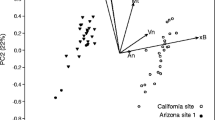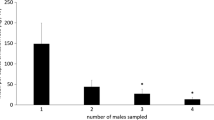Abstract
The catch of the western pine beetle,Dendroctonus brevicomis, at an attractive source of racemicexo-brevicomin, racemic frontalin, and myrcene was reduced by surrounding the source with a grid of 48 stations releasing all three compounds together, orexo-brevicomin alone or myrcene alone. Each compound was released at the rate of 2 mg/24 hr/station. The catch at an attractive bolt cut from a tree being colonized byD. brevicomis was not reduced byexo-brevicomin, but was reduced by the combination ofexo-brevicomin, frontalin, and myrcene in one of two tests. When a transect of traps was placed across a 0.81-hectare plot at six of the 48 stations releasing all three compounds, more beetles were caught at outer than at inner traps. More beetles were caught at unbaited traps on trees in a plot when the three compounds were released than when onlyexo-brevicomin or no compounds were released. A few trees were attacked byD. brevicomis in some of the plots. The antiattractant verbenone released from 48 stations at the rate of 4 mg/24 hr/station did not reduce the catch at an attractive tree bolt.
Similar content being viewed by others
References
Bedard, W.D., andBrowne, L.E. 1969. A delivery-trapping system for evaluating insect chemical attractants in nature.J. Econ. Entomol. 62:1202–1203.
Bedard, W.D., Tilden, P.E., Wood, D.L., Silverstein, R.M., Brownlee, R.G., andRodin, J.O. 1969. Western pine beetle: Field response to its sex pheromone and a synergistic host terpene, myrcene.Science 164:1284–1285.
Bedard, W.D., Tilden, P.E., Wood, D.L., Lindahl, K.Q., Jr., andRauch, P.A. 1980a. Effects of verbenone andtrans-verbenol on the response ofDendroctonus brevicomis to natural and synthetic attractant in the field.J. Chem. Ecol. 6:997–1014.
Bedard, W.D., Wood, D.L., Tilden, P.E., Lindahl, K.Q., Jr., Silverstein, R.M., andRodin, J.O. 1980b. Field responses of the western pine beetle and one of its predators to host- and beetle-produced compounds.J. Chem. Ecol. 6:625–641.
Borden, J.H. 1974. Aggregation pheromones in the Scolytidae, pp. 135–160,in M.C. Birch (ed.). Pheromones. North-Holland Publ., Amsterdam.
Browne, L.E. 1978. A trapping system for the western pine beetle using attractive pheromones.J. Chem. Ecol. 4:261–275.
Dethier, V.G., Browne, L.B., andSmith, C.N. 1960. The designation of chemicals in terms of the responses they elicit from insects.J. Econ. Entomol. 53:134–136.
Furniss, M.M., Kline, L.N., Schmitz, R.F., andRudinsky, J.A. 1972. Tests of three pheromones to induce or disrupt aggregation of Douglas-fir beetles (Coleoptera: Scolytidae) on live trees.Ann. Entomol. Soc. Am. 65:1227–1232.
Furniss, M.M., Daterman, G.E., Kline, L.N., McGregor, M.D., Trostle, G.C., Pettinger, L.F., andRudinsky, J.A. 1974. Effectiveness of the Douglas-fir beetle antiaggregative pheromone methylcyclohexenone at three concentrations and spacings around felled host trees.Can. Entomol. 106:381–392.
Furniss, M.M., Young, J.W., McGregor, M.D., Livingston, R.L., andHamel, D.R. 1977. Effectiveness of controlled-release formulations of MCH for preventing Douglas-fir beetle (Coleoptera: Scolytidae) infestation in felled trees.Can. Entomol. 109:1063–1069.
Gaston, L.K., Shorey, H.H., andSaario, C.A. 1967. Insect population control by the use of sex pheromones to inhibit orientation between the sexes.Nature 213:1155.
Hodges, J.L., andLehmann, E.L. 1962. Rank methods for combination of independent experiments in analysis of variance.Ann. Math. Stat. 33:482–497.
Huddleston, P.M., Mitchell, E.B., andWilson, N.M. 1977. Disruption of boll weevil communication.J. Econ. Entomol. 70:83–85.
Johnson, P.C., andCoster, J.E. 1978. Probability of attack by southern pine beetle in relation to distance from an attractive host tree.For. Sci. 24:574–580.
Lehmann, E.L. 1975. Nonparametrics: Statistical Methods Based on Ranks. Holden-Day, Inc., San Francisco, 457 pages.
Miller, J.M., andKeen, F.P. 1960. Biology and Control of the Western Pine Beetle. U.S. Dep. Agric. Misc. Publ. 800, Washington, D.C. 381 pages.
Mitchell, E.R. 1975. Disruption of pheromonal communication among coexistent pest insects with multichemical formulations.BioSci. 25:493–499.
Payne, T.L., Coster, J.E., andJohnson, P.C. 1977. Effects of slow-release formulation of syntheticendo- andexo-brevicomin on southern pine beetle flight and landing behavior.J. Chem. Ecol. 3:133–141.
Pitman, G.B., andVité, J.P. 1971. Predator-prey response to western pine beetle attractants.J. Econ. Entomol. 64:402–404.
Renwick, J.A.A., andVité, J.P. 1969. Bark beetle attractants: Mechanism of colonization byDendroctonus frontalis.Nature 224:1222–1223.
Richerson, J.V., andPayne, T.L. 1979. Effects of bark beetle inhibitors on landing and attack behavior of the southern pine beetle and beetle associates.Environ. Entomol. 8:360–364.
Rudinsky, J.A., Sartwell, C., Jr., Graves, T.M., andMorgan, M.E. 1974. Granular formulation of methylcyclohexenone: An antiaggregative pheromone of the Douglas-fir and spruce bark beetles (Col., Scolytidae).Z. Angew. Entomol. 75:254–263.
Shorey, H.H. 1977. Manipulation of insect pests of agricultural crops, pp. 353–367,in H.H. Shorey and J. J. McKelvey, Jr. (eds.). Chemical Control of Insect Behavior: Theory and Application. John Wiley and Sons, New York.
Shorey, H.H., Gaston, L.K., andSaario, C.A. 1967. Sex pheromones of noctuid moths. XIV. Feasibility of behavioral control by disrupting pheromone communication in cabbage loopers.J. Econ. Entomol. 60:1541–1545.
Smith, R.H. 1975. Formula for describing effect of insect and host tree factors on resistance to western pine beetle attack.J. Econ. Entomol. 68:841–844.
Stephen, F.M., andDahlsten, D.L. 1976. The arrival sequence of the arthropod complex following attack byDendroctonus brevicomis (Coleoptera: Scolytidae) in ponderosa pine.Can. Entomol. 108:283–304.
Tette, J.P. 1974. Pheromones in insect population management, pp. 399–410,in M.C. Birch (ed.). Pheromones. North-Holland Publ., Amsterdam.
Tilden, P.E., Bedard, W.D., Wood, D.L., Lindahl, K.Q., andRauch, P.A. 1979. Trapping the western pine beetle at and near a source of synthetic attractive pheromone: Effects of trap size and position.J. Chem. Ecol. 5:519–531.
Vité, J.P., andCrozier, R. G. 1968. Studies on the attack behavior of the southern pine beetle. IV. Influence of host condition on aggregation pattern.Contrib. Boyce Thompson Inst. Plant Res. 24:87–94.
Vité, J.P., andPitman, G. B. 1969. Insect and host odors in the aggregation of the western pine beetle.Can. Entomol. 101:113–117.
Vité, J.P., andPitman, G.B. 1970. Management of western pine beetle populations: Use of chemical messengers.J. Econ. Entomol. 63:1132–1135.
Vité, J.P., andRenwick, J.A.A. 1971. Inhibition ofDendroctonus frontalis response to frontalin by isomers of brevicomin.Naturwissenschaften 58:418.
Vité, J.P., Hughes, P.R., andRenwick, J.A.A. 1976. Southern pine beetle: Effect of aerial pheromone saturation on orientation.Naturwissenschaften 63:44.
Whitney, H.S., andCobb, F.W., Jr. 1972. Non-staining fungi associated with the bark beetleDendroctonus brevicomis (Coleoptera: Scolytidae) onPinus ponderosa.Can. J. Bot. 50:1943–1945.
Wood, D.L. 1972. Selection and colonization of ponderosa pine by bark beetles, pp. 101–117,in H.F. van Emden (ed.). Insect/Plant Relationships. Blackwell Scientific Publications, Oxford.
Wood, D.L. 1977. Manipulation of forest insect pests, pp. 369–384,in H.H. Shorey and J. J. McKelvey, Jr. (eds.). Chemical Control of Insect Behavior: Theory and Application. John Wiley and Sons, New York.
Wood, D.L., andBedard, W.D. 1977. The role of pheromones in the population dynamics of the western pine beetle, pp. 643–652.in D. White (ed.). Proceedings of the XV International Congress of Entomology. Washington, D.C. August 19–27, 1976.Entomol. Soc. Amer., College Park, Maryland.
Wood, D.L., Browne, L.E., Ewing, B., Lindahl, K., Bedard, W.D., Tilden, P.E., Mori, K., Pitman, G. B., andHughes, P.R. 1976. Western pine beetle: Specificity among enantiomers of male and female components of an attractant pheromone.Science 192:896–898.
Author information
Authors and Affiliations
Additional information
Coleoptera: Scolytidae.
These studies were supported by the Forest Service, U.S. Department of Agriculture, and in part by grants to the University of California from the U.S. National Science Foundation and U.S. Environmental Protection Agency (NSF GB-34718/BMS 75-04223) and the Rockefeller Foundation. The findings, opinions, and recommendations are not necessarily those of the funding agencies. Mention of commercial enterprises or products is only for information.
Rights and permissions
About this article
Cite this article
Tilden, P.E., Bedard, W.D., Wood, D.L. et al. Interruption of response ofDendroctonus brevicomis to its attractive pheromone by components of the pheromone. J Chem Ecol 7, 183–196 (1981). https://doi.org/10.1007/BF00988646
Received:
Revised:
Issue Date:
DOI: https://doi.org/10.1007/BF00988646




